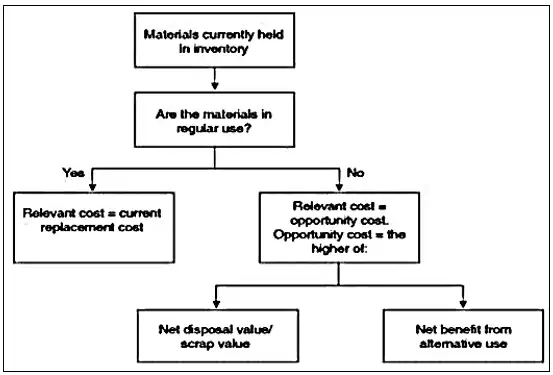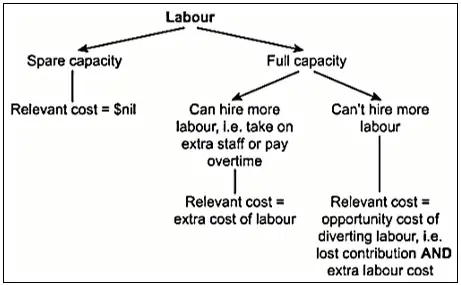- Cost planning
- Cost Analysis
- Cost management Techniques
- Externally oriented Cost Management Techniques
- Relevant costs
- Short term decisions
- Risk and Uncertainty
- Linear programming – graphical method
- Linear programming the simplex method
- Multi Product CVP Analysis
- Pricing decisions and Pricing strategies
- Budgetary Control
- Performance Evaluation
- Measuring performance in divisionalised businesses
- Transfer pricing
Relevant costs and revenues
Management make decisions about the future. When they make decisions for economic or financial reasons, the objective is usually to increase profitability or the value of the business, or to reduce costs and improve productivity.
Relevant costs should be used for assessing the economic or financial consequences of any decision by management. Only relevant costs and benefits should be taken into consideration when evaluating the financial consequences of a decision.
As a relevant cost is a future cash flow that will occur as a direct consequence of making a particular decision, it is used for target profit analysis as well.
The key concepts in this definition of relevant costs are as follows:
- Relevant costs are costs that will occur in the future. They cannot include any costs that have already occurred in the past.
- Relevant costs of a decision are costs that will occur as a direct consequence of making the decision. Costs that will occur anyway, no matter what decision is taken, cannot be relevant to the decision.
- Relevant costs are cash flows. Notional costs, such as depreciation charges, notional interest costs and absorbed fixed costs, cannot be relevant to a decision.
Several terms are used in relevant costing, to indicate how certain costs might be relevant or not relevant to a decision.
Incremental cost
An incremental cost is an additional cost that will occur if a particular decision is taken. Provided that this additional cost is a cash flow, an incremental cost is a relevant cost.
Differential cost
A differential cost is the amount by which future costs will be different, depending on which course of action is taken. A differential cost is therefore an amount by which future costs will be higher or lower, if a particular course of action is chosen. Provided that this additional cost is a cash flow, a differential cost is a relevant cost.
Avoidable and unavoidable costs
An avoidable cost is a cost that could be saved (avoided), depending whether or not a particular decision is taken. An unavoidable cost is a cost that will be incurred anyway.
Avoidable costs are relevant costs and Unavoidable costs are not relevant to a decision.
Committed cost
Committed costs are a category of unavoidable costs. A committed cost is a cost that a company has already committed to or an obligation already made, that it cannot avoid by any means. Committed costs are not relevant costs for decision making.
*Leases normally represent a committed cost for the full term of the lease, since it is extremely difficult to terminate a lease agreement.
Sunk costs
Sunk costs are costs that have already been incurred (historical costs) or costs that have already been committed by an earlier decision. Sunk costs must be ignored for the purpose of evaluating a decision, and cannot be relevant costs.
Opportunity costs
Relevant costs can also be measured as an opportunity cost. An opportunity cost is a benefit that will be lost by taking one course of action instead of the next-most profitable course of action.
This cost should be taken into consideration as a cost that would be incurred as a direct consequence of a decision. The opportunity cost is a relevant cost.
Relevant cost of materials
Relevant costs of materials are the additional cash flows that will be incurred (or benefits that will be lost) by using the materials for the purpose that is under consideration.
If none of the required materials are currently held as inventory, the relevant cost of the materials is simply their purchase cost.
If the required materials are currently held as inventory, the relevant costs are identified by applying the following rules:

Relevant cost of labor
The relevant cost of labor for any decision is the additional cash expenditure (or saving) that will arise as a direct consequence of the decision.

- If the cost of labor is a variable cost, and labor is not in restricted supply, the relevant cost of the labor is its variable cost.
- If labor is a fixed cost and there is spare labor time available, the relevant cost of using labor is 0. The spare time would otherwise be paid for idle time, and there is no additional cash cost of using the labor to do extra work.
- If labor is in limited supply, the relevant cost of labor should include the opportunity cost of using the labor time for the purpose under consideration instead of using it in its next-most profitable way.
Relevant cost of overheads
Relevant costs of expenditures that might be classed as overhead costs should be identified by applying the normal rules of relevant costing. Relevant costs are future cash flows that will arise as a direct consequence of making a particular decision.
Fixed overhead absorption rates are therefore irrelevant, because fixed overhead absorption is not overhead expenditure and does not represent cash spending.
However, it might be assumed that the overhead absorption rate for variable overheads is a measure of actual cash spending on variable overheads. It is therefore often appropriate to treat a variable overhead hourly rate as a relevant cost, because it is an estimate of cash spending per hour for each additional hour worked.
The only overhead fixed costs that are relevant costs for a decision are extra cash spending that will be incurred, or cash spending that will be saved, as a direct consequence of making the decision.
Relevant costs associated with non-current assets (Machinery)
Typical relevant cash flows
- The purchase price of any new machinery that needs to be bought.
- If an existing machine is to be used in the project that would otherwise have been sold, then there is an opportunity cost equal to the proceeds foregone.
- Scrap/disposal proceeds on new assets bought.
- If we need to take an existing machine from another department and it is not replaced (either by choice or because a replacement is not available), then there is an opportunity cost equal to the lost contribution from the other department would need to be included.
Items that are not relevant
- Depreciation is not a cash flow so is never relevant.
- Profit or loss on disposal incorporates accumulated depreciation so is not relevant – instead look at the cash element only – i.e. the scrap proceeds.
- The original purchase price of existing machinery is a sunk cost.
- The NBV of existing machinery is a combination of the original price (sunk) and accumulated depreciation (not a cash flow).
